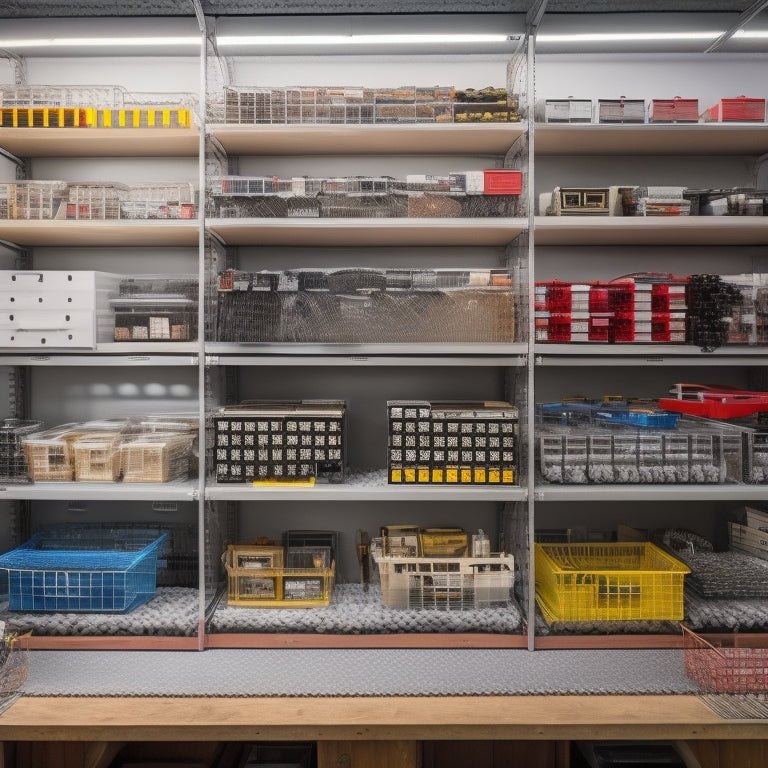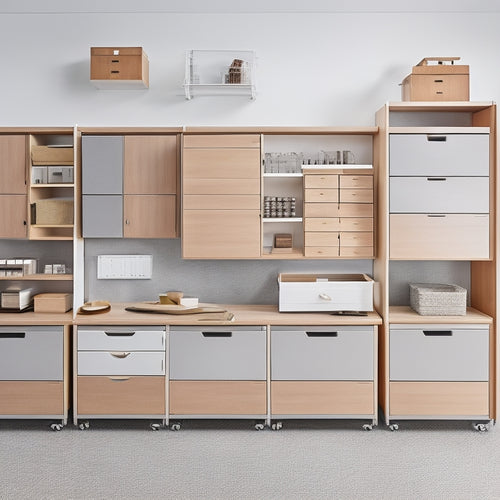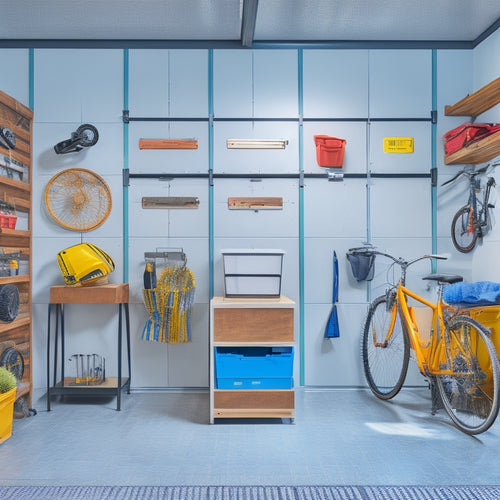
10 Essential Steps for Small Parts Bin Storage
Share
To optimize your small parts bin storage, start by defining your storage needs and goals, considering factors like available space, part size, and access frequency. Next, choose the right bin size and materials, ensuring they accommodate your parts efficiently while meeting durability and cost requirements. Then, organize and label your bins by part type, implementing a retrieval system that streamlines your workflow. Maintain accurate inventory levels, schedule regular bin cleaning, and monitor your storage system to identify areas for improvement. By following these essential steps, you'll be well on your way to maximizing storage efficiency - and there's more to uncover when you take the next step.
Key Takeaways
- Evaluate available space and determine capacity required based on the number of parts and access frequency to optimize storage efficiency.
- Choose the right bin size and materials considering durability, cost, and environmental impact to ensure proper storage and protection of parts.
- Organize and label bins logically and clearly to improve efficiency, optimize workflow, and enhance visual management and inventory tracking.
- Assign bin locations strategically to ensure easy accessibility, minimize clutter, and reduce travel distances, and implement effective retrieval systems.
- Regularly maintain accurate inventory levels, schedule bin cleaning, and monitor storage systems to prevent stockouts, overstocking, and contamination.
Define Storage Needs and Goals
When tackling small parts bin storage, you must first define your storage needs and goals. This involves evaluating the available space where the bins will be stored, contemplating the dimensions and layout of the area.
You'll need to define the capacity required, factoring in the number of parts to be stored and the frequency of access. Identifying priorities is also vital, as it will help you determine which parts need to be stored in easy-to-reach locations.
Setting clear objectives is essential, such as reducing storage costs, increasing efficiency, or improving inventory management. Evaluating the efficiency of your current storage system will help you pinpoint areas for improvement.
Determining your budget for the storage solution will also guide your decision-making process. Analyzing your workflow will reveal opportunities to streamline processes and reduce waste.
Additionally, considering scalability will guarantee that your storage solution can adapt to future growth or changes in your operations. By carefully defining your storage needs and goals, you'll be able to create a customized solution that meets your specific requirements.
Choose the Right Bin Size
With your storage needs and goals clearly defined, you're now ready to select the ideal bin size for your small parts storage system. This critical step guarantees you maximize storage efficiency while maintaining easy access to your components.
To choose the right bin size, consider the dimensions of the items you'll be storing. Measure the length, width, and height of your smallest and largest parts to determine the minimum and maximum bin dimensions required. This will help you avoid wasted space and prevent overcrowding, which can lead to damage or loss of parts.
Opt for bins with adjustable dividers or compartments to accommodate varying part sizes and optimize storage capacity. Additionally, consider the bin's volume and weight capacity to guarantee it can handle the total weight of the stored items.
Select Appropriate Bin Materials
Bin materials play an essential role in guaranteeing the durability and effectiveness of your small parts storage system. You'll want to choose materials that meet your specific needs, considering factors such as durability, cost, environmental impact, and customization options.
When evaluating bin material types, consider the following key characteristics:
| Material Type | Durability Considerations | Cost Analysis |
|---|---|---|
| Plastic | Resistant to corrosion and chemicals, but prone to cracking | Low to moderate cost, depending on quality |
| Metal | Durable and resistant to heavy use, but may rust or corrode | Moderate to high cost, depending on material |
| Wood | Aesthetically pleasing, but susceptible to moisture damage | High cost, due to customization requirements |
| Hybrid | Combines benefits of multiple materials, but may be prone to wear | Moderate cost, depending on material combination |
Additionally, consider supplier options, safety features, and aesthetic choices when selecting bin materials. Confirm that your chosen material meets safety standards and regulations, and aligns with your facility's environmental policies. By carefully evaluating these factors, you'll be able to select the most appropriate bin materials for your small parts storage system.
Organize Bins by Part Type
Several dozen bins, each filled with unique small parts, can quickly become overwhelming without a clear organization system. To avoid this chaos, you'll need to organize your bins by part type. This involves categorizing your parts into logical groups, such as fasteners, electrical components, or mechanical parts.
By doing so, you'll improve efficiency, optimize workflow, and enhance space management. Organizing your bins by part type also enables visual organization, making it easier to locate specific parts when needed. This, in turn, streamlines inventory tracking and reduces costs associated with lost or misplaced items.
Additionally, standardizing your parts and their corresponding bins guarantees compliance with safety standards and promotes a culture of safety within your organization.
Label and Sign Each Bin
You'll need to implement a clear bin identification method to guarantee easy location of specific parts.
This involves establishing clear labeling standards, such as using text, color-coding, or icons, to distinguish one bin from another.
Bin Identification Methods
Effective small parts bin storage relies on a well-organized system, and one vital aspect of this system is identifying each bin accurately. You'll want to implement a bin identification method that guarantees quick and easy location of specific parts.
Color coding is a simple yet effective approach, where bins are categorized by color based on part type, size, or material. Barcode scanning is another popular method, allowing you to quickly scan and retrieve part information.
Visual management is also essential, as it enables you to visually identify bins and their contents. Digital tracking systems can be integrated with barcode scanning, providing real-time inventory updates.
RFID tagging is another option, offering automated tracking and inventory management. When categorizing bins, consider size categorization, material differentiation, and part prioritization to guarantee efficient storage and retrieval.
Clear Labeling Standards
Set clear labeling standards by designating a specific label format for each bin, guaranteeing consistency throughout your storage system. This consistency enables you to implement effective labeling techniques that provide quick reference and facilitate efficient bin identification.
Use standardized formats to guarantee visual cues are easily recognizable. Color coding can be an effective way to categorize and distinguish between different types of parts. Additionally, consider digital labeling options, which can be easily updated and customized.
When designing your labels, prioritize font size and clarity. Make certain the text is large enough to be easily readable, even from a distance. This is essential for maintaining a safe working environment, as it reduces the risk of misidentification and associated accidents.
Assign Bin Locations Carefully
Assigning bin locations carefully is essential to maintaining a well-organized small parts storage system. When you assign bin locations carefully, you guarantee that your parts are easily accessible, reducing the risk of accidents and injuries caused by clutter and disorganization.
To optimize bin locations, consider the spatial arrangement of your storage area. You want to minimize travel distances and reduce congestion in the aisles. Group similar parts together and place frequently used items in easy-to-reach locations.
Here is an example of how you can organize your bin locations:
| Bin Location | Part Characteristics |
|---|---|
| Aisle 1, Top Shelf | Small, lightweight parts (e.g., screws, nuts) |
| Aisle 2, Middle Shelf | Medium-sized parts (e.g., gears, motors) |
| Aisle 3, Bottom Shelf | Large, heavy parts (e.g., machinery components) |
| Aisle 4, Near Workstations | Frequently used parts (e.g., fasteners, tools) |
Implement a Retrieval System
You'll need to design a retrieval system that allows you to efficiently locate and access the parts you need.
This involves implementing effective bin organization methods, such as categorizing bins by part type or frequency of use.
Bin Organization Methods
Implementing an effective retrieval system is crucial for maximizing the efficiency of your small parts bin storage. You'll want to take into account various bin organization methods to guarantee easy access and visibility of your stored items. One effective approach is to use a color-coding system, where bins are labeled and categorized by specific colors to indicate the type of parts stored. This method is especially useful when combined with modular bins that can be easily rearranged as your storage needs change.
You can also optimize your storage space by using bin stacking, which allows you to store more bins in a smaller footprint. However, be certain to take into account the weight capacity and material durability of your bins to verify they can withstand the weight of the stacked bins.
| Bin Organization Method | Description | Benefits |
|---|---|---|
| Color Coding | Label and categorize bins by color | Easy identification and access |
| Modular Bins | Interchangeable bins for flexibility | Customization options and space optimization |
| Bin Stacking | Stack bins to maximize storage space | Increased storage capacity and weight capacity |
Easy Access Design
Every small parts bin storage system requires a well-designed retrieval system to guarantee efficient access to stored items. This means you'll need to implement a system that allows for quick retrieval and reduces the risk of accidents or injuries.
To achieve this, focus on user-friendly designs that feature efficient layouts and ergonomic access. This can be achieved through customizable options, such as modular systems that can be customized to your specific needs.
Look for space-saving solutions that offer flexible configurations, allowing you to adapt your storage system as your needs change. Compact designs and intuitive arrangements will help you maneuver your storage system with ease, reducing the time spent searching for parts.
Maintain Accurate Inventory Levels
Since inaccurate inventory levels can lead to stockouts, overstocking, and decreased productivity, maintaining accurate inventory levels is crucial in small parts bin storage. You must verify that your inventory tracking system is accurate and up-to-date to prevent loss prevention and verify smooth supply chain operations.
To achieve stock accuracy, you should conduct regular inventory audits and analyze data to identify trends and patterns in demand forecasting. This will help you set ideal reorder points and maintain efficient inventory turnover. Implementing software solutions can streamline your inventory tracking process and provide real-time data analysis.
Here is a summary of the key benefits of maintaining accurate inventory levels:
| Aspect | Benefit | Impact |
|---|---|---|
| Inventory Tracking | Reduced stockouts | Increased productivity |
| Demand Forecasting | Improved supply chain efficiency | Reduced overstocking |
| Inventory Turnover | Enhanced storage space | Reduced loss prevention |
| Reorder Points | Timely replenishment | Reduced stockouts |
| Data Analysis | Informed decision-making | Improved supply chain management |
Schedule Regular Bin Cleaning
Your small parts bin storage system is only as good as the cleanliness of its bins. To guarantee peak performance and safety, you must schedule regular bin cleaning. Determine a suitable cleaning frequency based on usage and environmental factors. For high-traffic areas or dusty environments, you may need to clean bins daily or weekly. In cleaner environments, monthly or quarterly cleaning may be sufficient.
Create a cleaning checklist to guarantee thoroughness. This should include tasks such as removing debris, wiping down bins with a gentle cleaning solution, and inspecting for damage or wear. Choose cleaning methods that won't damage bin labels or compromise the integrity of the storage system.
Designate a specific individual or team for cleaning responsibility to guarantee accountability and consistency. Regular bin cleaning prevents contamination, reduces the risk of accidents, and maintains the overall organization of your storage system. By incorporating cleaning into your routine, you can rely on your small parts bin storage system to perform efficiently and safely.
Monitor and Adapt Storage System
You need to regularly monitor your small parts bin storage system to guarantee it remains efficient and effective.
This involves conducting storage system audits to identify bottlenecks, performing inventory level checks to prevent stockouts or overstocking, and making bin allocation updates to optimize storage capacity.
Storage System Audits
Implementing a storage system is only the first step; the next crucial phase involves monitoring and adapting it to guarantee it continues to meet your changing needs.
To verify your storage system remains optimized, you'll need to conduct regular storage system audits. This involves creating an audit checklist to assess your system's performance and identify areas for improvement.
During the audit, you'll evaluate storage efficiency, compliance with regulatory standards, and inventory accuracy. You'll also analyze performance metrics to identify opportunities for process enhancement, waste reduction, and cost savings. This analysis will help you optimize your storage space and reduce costs.
Additionally, you'll assess employee training and identify areas where additional training may be needed.
By regularly conducting these audits, you'll be able to adapt your storage system to meet your developing needs, ensuring it remains a significant asset to your organization.
Inventory Level Checks
Inventory level checks are a crucial aspect of monitoring and adapting your storage system. These checks enable you to track the quantities of small parts in each bin, ensuring you're aware of what's running low and what's overstocked.
By regularly checking inventory levels, you can identify potential stockouts or overstocking issues before they become major problems.
To conduct effective inventory level checks, you'll need to implement an inventory tracking system. This can be a manual system, such as a spreadsheet or a physical count, or an automated system, like a barcode scanner or inventory management software.
Regardless of the method, it's important to set a regular schedule for checks, such as daily, weekly, or monthly, depending on your storage system's needs.
When conducting inventory level checks, pay attention to bins that are nearly empty or overflowing. This will help you determine when to initiate stock replenishment, preventing delays or production downtime.
Bin Allocation Updates
Optimized bin allocation is critical to maintaining a well-organized and efficient storage system. As you monitor and adapt your storage system, you'll need to regularly update your bin allocation to guarantee it continues to meet your changing needs. This involves reassessing your bin allocation strategies to optimize storage capacity and reduce waste.
| Bin Reassessment Strategies | Bin Allocation Efficiency | Benefits |
|---|---|---|
| Review inventory levels | Identify underutilized bins | Reduce waste, optimize storage capacity |
| Analyze storage layout | Rearrange bins for better access | Improve workflow, reduce labor costs |
| Implement bin rotation | Guarantee first-in, first-out inventory management | Reduce obsolescence, improve inventory freshness |
| Conduct regular audits | Identify opportunities for improvement | Maintain a well-organized and efficient storage system |
Frequently Asked Questions
How Often Should I Rotate Stock to Prevent Part Obsolescence?
You should rotate your stock every 6-12 months to prevent part obsolescence, ensuring that older items are used or disposed of before they become outdated, and implementing a first-in, first-out system for ideal obsolescence management.
Can I Use Small Parts Bins for Storing Hazardous Materials?
You step into a warehouse, surrounded by rows of small parts bins, but pause, wondering if they're suitable for storing hazardous materials. The answer is no, as these bins aren't designed for storage safety, and using them could lead to catastrophic consequences.
Are There Any Specific Regulations for Storing Electronic Components?
You'll need to comply with specific safety standards and storage guidelines when storing electronic components, ensuring you meet regulations like IPC-A-610 and ANSI/ESD S20.20 to prevent damage, electrostatic discharge, and contamination.
How Do I Handle Mixed-Part Bins With Varying Sizes and Shapes?
When handling mixed-part bins with varying sizes and shapes, you'll need to implement a mixed-part organization system, utilizing storage solutions like dividers, compartments, and adjustable shelving to guarantee safe and efficient storage, preventing damage and misplacement.
Can I Customize Bin Sizes for Unique or Oversized Parts?
You'll need custom bin solutions that accommodate oversized part considerations, ensuring a snug fit and preventing damage or movement during storage and transportation, which is essential for maintaining safety and preventing accidents in the workplace.
Conclusion
You've finally implemented your small parts bin storage system, but don't think you can rest on your laurels just yet. As you settle into your new organizational rhythm, remember that complacency is the enemy of efficiency. Stay vigilant, and keep a watchful eye on your inventory levels, bin cleanliness, and retrieval system. One misstep, and your carefully crafted system can quickly devolve into chaos. Will you be able to maintain the order, or will entropy win the day? Ultimately, the future will reveal.
Related Posts
-

Modular Tool Storage Systems for Small Spaces
You can optimize your small workspace by leveraging modular tool storage systems that intelligently employ vertical s...
-

3 Pro Garage Organization Ideas to Try Now
You can alter your garage from cluttered chaos to organized oasis with three pro garage organization ideas. First, op...
-

Best Organizing Tools for a Clutter-Free Space
You're on a mission to change your cluttered space into a peaceful oasis, and you're looking for the best organizing ...


